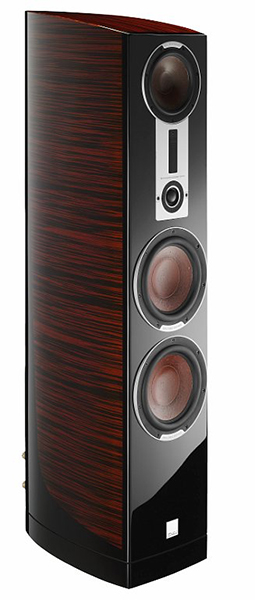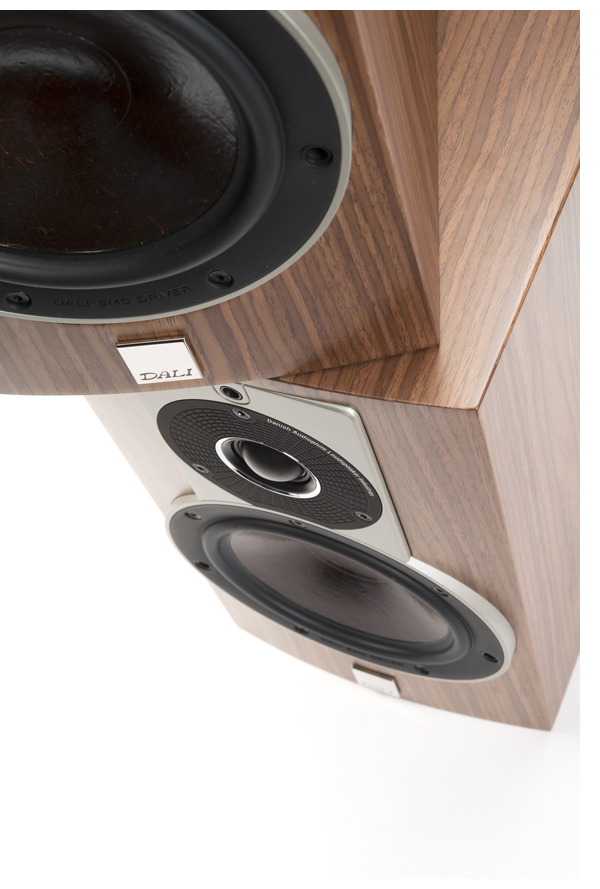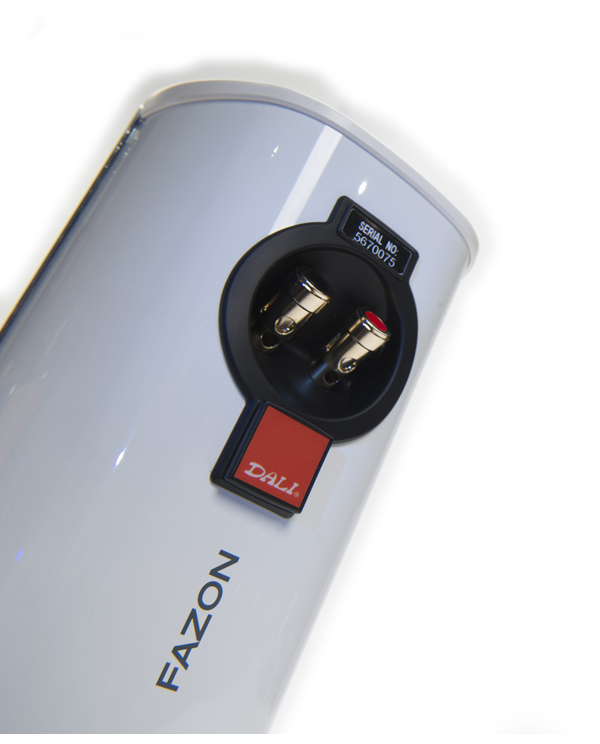 If you happen to peruse any number of reviews concerning speakers in the twenty to thirty thousand dollar price range, which is still a massive amount of money for most people, the review conclusion (some of my own reviews included) goes something like this: “The only thing speaker X gives up to the mega speakers is that last bit of extension, dynamics and low frequency extension.”
If you happen to peruse any number of reviews concerning speakers in the twenty to thirty thousand dollar price range, which is still a massive amount of money for most people, the review conclusion (some of my own reviews included) goes something like this: “The only thing speaker X gives up to the mega speakers is that last bit of extension, dynamics and low frequency extension.”
Not any more. Judging from external appearance, the Dali Epicon 8s are finished as exquisitely as anything you’ll find in the market with another zero on the price tag. The Danes are famous for beautiful cabinetry and the Epicon 8s do not disappoint, the hand rubbed Ruby Magassar high gloss lacquer finish is simply stunning. Every one of my audiophile buddies that weren’t familiar with these speakers thought they were considerably more expensive, shocked to see this level of fit and finish on a 20 thousand dollar pair of speakers. But there are plenty of gorgeous speakers that you wouldn’t pay this kind of money for. Regardless of finish you choose, the slim, 14-inch wide front baffle of the Epicon 8 should blend into any décor.
If you’ve heard any of Dali’s smaller loudspeakers, you know that this Danish manufacturer packs major performance into a compact package, and always at a much lower price than you might expect. And for good reason – they have a 250,000 square foot facility where they design and build everything from cabinet to crossover and drivers. This large scale of manufacturing and engineering prowess is what enables Dali to make a more engaging speaker than most at a specific price point.
After just reviewing the Rubicon 2, (www.tonepublications.com/review/dali-rubicon-2-speakers) and a recent visit to the Dali factory, it’s easy to see why we are so smitten with their speakers. Offering excellent value, excellent sound and understated elegance that the Danes are famous for, the 20 thousand dollar question is what can they accomplish at that price? When you’ve got 20 big ones to spend, the competition gets serious, but after spending a few months with the Epicon 8, I put them at the top of the heap and serious competition for speakers costing $40k – $50k; they’re that good. This is what economies of scale deliver.
Beauty that’s more than skin deep
The Epicon 8s do it all. They disappear in the room just as easily as the Epicon 2s we recently reviewed, yet move a lot of air when big dynamic swings demand it. Starting with Alex DeGrassi’s Southern Exposure on early Windham Hill vinyl, every bit of harmonic structure comes through effortlessly as he picks, with not only the texture of his guitar sounding true to form, but the speakers actually recreating the size of the instrument in the space between the speakers – a tough act to pull off.
If you’ve ever heard your favorite acoustic guitarist play through a pair of Magnepans or MartinLogan speakers, they sometimes can recreate a larger than life presentation. While this is always fun and exciting, (and I write this as a panel lover) those listening to a lot of acoustic faire will be upset by all instruments sounding overblown with their favorite panel speaker. Yet the Epicon 8s allow a guitar to sound like a guitar, a violin like a violin and an oboe like an oboe from not only a tonal perspective, but a spatial one as well. If you crave realism, the Epicon 8 is for you.
 With the power output meters on the Audio Research GS 150 power amplifier buried into the red zone, Focus’ legendary prog track, “Hocus Pocus” never sounded bigger and better. When called upon to really rock, the Epicon 8s do not disappoint and the dual 8” woofers that transition to a 6 1/2’” midrange in a three and a half way configuration. It takes a lot to flatten out the power delivery of the GS150, yet I was able to clip the amplifier before the speakers gave up. They had to be moved to the Pass Labs Xs300 monos to be driven to their limit. At this point, rather than clip harshly, all of the front to back depth flattens out, gently to where rotating the volume control any further clockwise has no further effect. Keep in mind that this occurs at an incredibly high volume level – our SPL meter confirmed 114 db peaks, exceeding the 112db on the Dali spec sheet.
With the power output meters on the Audio Research GS 150 power amplifier buried into the red zone, Focus’ legendary prog track, “Hocus Pocus” never sounded bigger and better. When called upon to really rock, the Epicon 8s do not disappoint and the dual 8” woofers that transition to a 6 1/2’” midrange in a three and a half way configuration. It takes a lot to flatten out the power delivery of the GS150, yet I was able to clip the amplifier before the speakers gave up. They had to be moved to the Pass Labs Xs300 monos to be driven to their limit. At this point, rather than clip harshly, all of the front to back depth flattens out, gently to where rotating the volume control any further clockwise has no further effect. Keep in mind that this occurs at an incredibly high volume level – our SPL meter confirmed 114 db peaks, exceeding the 112db on the Dali spec sheet.
The other area the Epicon 8s exceed their specs is in low frequency extension. While not overly scientific, they are claimed 3db down at 35hz, yet even 25hz test tones are barely diminished in comparison to the 30 and 40hz tones, at least in my test room. Playing music in the real world proves equally compelling; whether you prefer Infected Mushroom or Genesis, the Epicon 8s go deep.
Final Setup Tweeks
In fact, they had a bit too much LF energy to work in reviewer Rob Johnson’s room, so placement is somewhat critical to get the right bass character. Tipping the scales at slightly more than 100 pounds each (48kg) get a friend to help you place the Epicon 8s. Impeccable time domain performance (a major design priority at Dali) and wide dispersion means all you need to do is lock in the bottom end and your rolling; the supplied spikes prove essential to achieving the best room interface.
Replacing the flat metal jumpers with some custom jumpers from the Chord Company takes the Epicon 8s to 11. Because the midrange to extreme high frequency range is so clean, you don’t notice it until you remove them and swap the Chord jumpers in place – you’ll instantly notice the additional smoothness they now offer. Of course, if your speaker cables happen to be terminated for bi-wired operation, just as well.
Dali makes amazing soft dome tweeters that achieve a magic balance of resolution and natural tonal balance and their implementation of the ribbon tweeter in the Epicon 8 is a perfect example of the Danes doing things a bit differently. Worre again comments, “We use the ribbon as a supertweeter, crossing over at about 15khz, so that it just adds extra ambience to the presentation. Using it this way also avoids any diaphragm breakup from crossing it over at a lower frequency.”
Truer words were never spoken. Much like the depth a system picks up when able to utilize a subwoofer going down below 20hz, the supertweeter adds an ambience that is easily experienced by covering it up. Even a few friends that I know have limited HF hearing could easily perceive the difference between supertweeter engaged and not in a darkened room, and they all described the added depth and sparkle the same way. Cymbals have more shimmer and immediacy and even audience participation has more depth, more palpability, and more realism. The character of the room in Jeff Beck’s classic live album from Ronnie Scott’s jazz club in the UK is unmistakable. All I need do is close my eyes and I’m back there. Incredible. It’s like the two tweeters blend effortlessly to become one super duper tweeter – no matter what I played; I could not determine a crossover between them.
Resolution without edge
The better the source material and associated components, the better the Epicon 8s perform. Lowering the stylus on the MoFi pressing of Joe Jackson’s Night And Day instantly reveals the delicacy portrayed by the Epicon 8s. Even starting with my PrimaLuna ProLogue integrated amplifier, producing 35 watts per channel of tube power, these speakers sound incredible.
Thanks to a sophisticated crossover network that doesn’t sap power, as some multi-way, multi-driver speakers do, the Epicon 8s offer up an 89db sensitivity rating. Even 35 or 40 watts per channel will allow them to play fairly loud. We were even able to achieve great results with a 12 watt per channel Pass Labs First Watt amplifier, so whether you are buying the Epicon 8s as an anchor to a system that will be upgraded in the future, or as a final speaker purchase after a line of component upgrades, the Epicon 8s will satisfy.
Steadily going up the ladder, swapping DACs from the excellent, sub-$1,000 Rega DAC all the way to the $100,000 plus dCS Vivaldi, the Dali speakers easily reveal the nuances each DAC brings to the mix. Analog experiences prove equally vivid, moving from my favorite budget cartridge, the Denon DL-103r to the $15,000 Clearaudio Goldfinger. These speakers are a joy to use for any level of involvement and can easily be used as a reviewers tool to judge other components, thanks to their natural tonal balance, lack of distortion and coherence.
As much as there is to like about the Dali Epicon 8 speakers, their balance of all speaker parameters, combined with a high level of resolution that never becomes harsh is their greatest strength. The Dali engineers have not compromised any single aspect of musical reproduction at the expense of overall balance, and that’s what makes these speakers so amazing. Days of long listening sessions deliver zero fatigue, no matter what the listening level, and whether blasting Thriller, or playing Frank Sinatra at conversation level, I am always fully engaged by these speakers, hearing nuances that I thought I needed a $100,000 pair of speakers to realize.
 So, DO you need a $100,000 pair of speakers?
So, DO you need a $100,000 pair of speakers?
Only if you have the money to throw around and need the bragging rights, or you love to play pipe organ music at concert hall levels. For the rest of you, the Dali Epicon 8 can easily be your final loudspeaker purchase. They serve the music faithfully.
While it is often a nebulous yardstick, these speakers really groove, allowing you to enjoy whatever music you happen to love. Those having widely eclectic tastes will never be limited by what their speakers can do tonally or dynamically.
The Dali Epicon 8 Loudspeakers
$19,995/pair
www.dali-speakers.com (factory)
www.soundorg.com (US Distributor)
Peripherals
Analog Source AVID Acutus Reference SP/SME V/Clearaudio Goldfinger Ref.
Digital Source dCS Vivaldi, Gryphon Kalliope
Phonostage Simaudio MOON LP810
Preamplifier ARC GSPre, Robert Koda K-10, Pass Labs Xs Pre
Power Amplifier ARC GS150, Pass XA160.8, Pass Xs Monos
Cable Cardas Clear
Power IsoTek Super Titan









 As the starship
As the starship 













